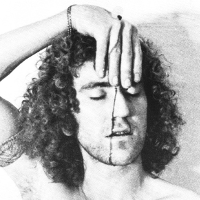Die Weise von Liebe und Tod (1988)
 Installatie (Museum Prinsenhof, Delft)
Installatie (Museum Prinsenhof, Delft)
Media
Omschrijving
 De installatie - ruimte bestaat uit een bassin van 10 m. x 8 m. x 0. I 0 m. aan de achterkant afgesloten met zwarte spiegels (8 m. x 2.5 m.). In het midden van het bassin staat een cubus van zwart glas (2 m. x 0.75 m. x 0.6 m.). Op deze cubus staat een monitor, die gezichten van oude vrouwen laat zien.
De installatie - ruimte bestaat uit een bassin van 10 m. x 8 m. x 0. I 0 m. aan de achterkant afgesloten met zwarte spiegels (8 m. x 2.5 m.). In het midden van het bassin staat een cubus van zwart glas (2 m. x 0.75 m. x 0.6 m.). Op deze cubus staat een monitor, die gezichten van oude vrouwen laat zien.
De voorkant van het bassin is begrensd door een wand van 2.5 m. hoog, met een smalle doorkijk in het midden. De naar het bassin gerichte kant laat via de zwarte spiegels aan de achterkant namen, geboorte- en sterfdata van tijdens de tweede wereld-oorlog gesneuvelde soldaten zien.
De zwarte spiegels reflecteren ook de beelden van twee in de voorkant ingebouwde monitoren.
Monitor A:
portretten van beroemde mensen uit deze periode.
Monitor B:
portret van een klein meisje, dat naar de camera kijkt.
Al meer dan vijfentwintig jaar begeleidt Rainer Maria Rilke's boek 'Die Weise von Liebe und Tot des Cornets Christoph Rilke' mij. Iemand van wie ik hield schreef het met de hand over. De manier waarop ik het in de loop van de jaren las, weerspiegelt mijn ontwikkeling van kind naar volwassene. Aanvankelijk was ik vol bewondering voor het romantisch heroïsche. Later ontdekte ik de schoonheid van de taal en weer later, met beelden van Verdun en Hiroshima voor ogen, las ik het met een kritische distantie.
De studie aan de kunstacademie ging samen met s'nachts werken in ziekenhuizen. Daarna, als kunstenaar, verdiende ik mijn geld in psychiatrische inrichtingen, met hun troosteloze gangen en ontredderde mensen. Weer later zorgde ik voor mensen, die thuis op sterven lagen.
Overdag kunst, s'nachts de dood. Kunst en dood bestonden en bestaan naast elkaar, heroïsch, vol schoonheid, tragisch, banaal. De betekenis ervan lag nergens in besloten.
Wij zijn het, die de betekenis eraan toevoegen.
Heiner Holtappels, 1989
Description
 The installation space consists of a pool measuring 10 m. x 8 m. x 0. I m., closed at the rear by black mirrors (8 m. x 2.5 m. ). A cube of black glass (2 m. x 0.75 m. x 0.6 m. ) stands at the centre of the pool. A monitor supported on the cube shows the faces of elderly women.
The installation space consists of a pool measuring 10 m. x 8 m. x 0. I m., closed at the rear by black mirrors (8 m. x 2.5 m. ). A cube of black glass (2 m. x 0.75 m. x 0.6 m. ) stands at the centre of the pool. A monitor supported on the cube shows the faces of elderly women.
The front of the pool is bounded by a 2.5 m. high wall with a small viewing hole at the centre. The side facing the pool bears the names and the dates of birth and death of soldiers who were killed in the war. This information is legible as a reflection in the black mirrors at the rear.
The black mirrors also reflect the images of two monitors which are built into the front wall.
Monitor A:
portraits of famous people of this period.
Monitor B:
portrait of a little girl looking towards the camera.
PERSONAL NOTE
For more than twenty-five years, Rainer Maria Rilke's book 'Die Weise von Liebe and Tod des Cornets Christoph Rilke' has been my guide. Someone I loved copied it by hand. The way I read it in the course of the years reflected my development from childhood to adulthood. Originally I was full of admiration for the romantic heroism. Later I discovered the beauty of the language, and, later still, with images of Verdun and Hiroshima on my mind, I read it with a certain critical distance.
My studies at art college were paired with a night job in a hospital. Later as an artist I earned my living in psychiatric institutions, with their grim corridors and shattered individuals. After this I cared for people dying at home.
Art by day, death by night. Art and death existed then as now alongside each other, heroic, full of beauty, tragic and banal. There was no hidden meaning.
It is we who impose the meanings.
Heiner Holtappels, 1989
